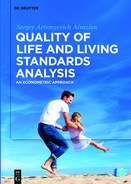Contents
Introduction
I.1 On the Meaning of the Concept “Quality of Life”
I.2 Why do we need to andwhy we canMeasure the Quality of Life
I.3 Two Methological Approaches to Evaluation and Measurement of Quality of Life (Micro- and Macro-Analysis)
I.4 Conclusions
1 Main Theoretical Concepts of Quality of Life (QOL) and Examples of Approaches to its Measurement
1.1 The Choice of a Certain Theoretical Concept of Quality of Life Depends on the Answers to Which Questions?
1.2 The Basic Theoretical Concepts of Quality of Life
1.3. Methods of Measuring the Quality of Life (World Experience)
1.4. Analysing the Properties of Integral Indicators Quality of Life
1.5 Conclusions
2 Macroeconometric Analysis of Quality of Life: Measurement of the Synthetic Latent Categories
2.1 Integral Components of “quality of life” category and their analysis
2.2 Requirements for the formation of a priori set of statistical parameters for different synthetic categories of quality of life of the population
2.3 Measurement methodology of synthetic categories of the quality of life and methods of mullticriteria rating of the territories (countries, subjects of russian federation, municipalities)
2.4 Examples of building integrated indicators of quality of life in crosscountry and inter-country analysis
2.5 Conclusions
3 Macro-Econometric Analysis of Quality of Life Within the Framework of Evaluating the Effectiveness of Socio-Economic Policy
3.1 General logistics of the use of integral quality of life indicators within the framework of effective socio-economic policy
3.2 Parameters of socio-economic policy and institutional development as determinants of the improved qolp (the results of inter-country econometric analysis)
3.3 Identifyication of key areas of improvement of social and economic policy in the russian federation regions
3.4 Conclusions
4 Microeconometric Analysis of Quality of Life and Living Standards
4.1 Types of consumer behaviour households and identification of key typological characteristics
4.2 Analysis and modelling of the distribution relations in society
4.3 Problems of information support of microeconometric analysis of the level and lifestyle of population
4.4 Conclusions
A2 Appendices to Chapter 2
A2.1 The structure and content of the information included in WCY (The World Competitiveness Yearbook)
A2.2 A priori and a posteriori synthetic sets of partial criteria category of “life quality” in a cross-country analysis (according to WCY 2009)
A2.3 Original and standardized statistical data for the cross-country analysis (source: WCY, 2009)
A2.4 results of the implementation of the procedures for formation posteriori set particular criteria QOL priori set of cross-country analysis
A2.5 The results of the calculated QOL index and ranking countries according to WCY [2009]
A2.6 A priori and a posteriori partial criteria for each of the categories of synthetic quality of life of the Russian Federation regions
A2.7 Initial statistics posterior set of indicators (in initial and unified form) in regions of Russia
A2.8 The values of the block and consolidated II for the regions of the Russian Federation for each synthetic category
A2.9 The values of consolidated QOL index and corresponding ranks for the regions of the Russian Federation
A3 Appendices to Chapter 3
A3.1 Resulting values for indicators (criterion) of synthetic quality categories and lifestyle y(1)−y(4) and relevant explanatory variables x(1)−x(17) for 60 countries and regions (source of data [WCY, 2004])
A3.2 Dynamics of the determinant variables measured in physical units (data sources – yearbooks [WCY, 1998–2004])
A3.3 A priori set of indicators of social and economic policy and institutional development in the region of the Russian Federation
A3.4 Initial data for econometric analysis of dependences of the integral life quality indicators on the characteristics of social and economic policy and institutional development in the region
A4 Appendices to Chapter 4
A4.1 Some auxiliary information on methods and algorithms of statistical processing of non-quantitative characteristics
A4.2 Probability of the household survey evasion as a function of some of its characteristics (analysis results)
A4.3 The results of the statistical analysis of the models of mixtures of distributions within the statistical observed range of values of total per capita expenditures of households
A4.4 Results of nonparametric analysis of the distribution of population of Russia’s regions and the country as a whole on the value of total per capita expenditures
References
..................Content has been hidden....................
You can't read the all page of ebook, please click here login for view all page.
